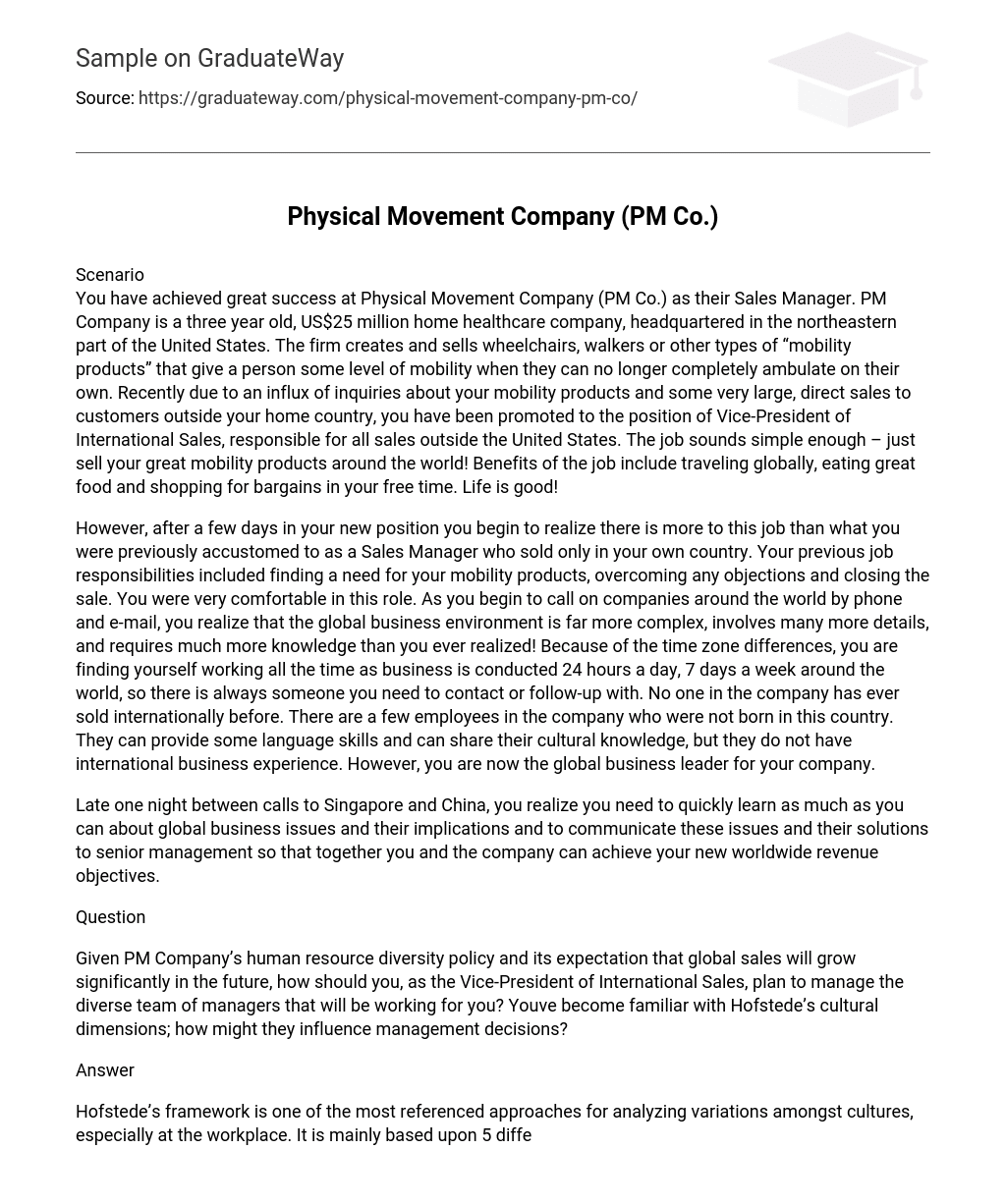Scenario
You have achieved great success at Physical Movement Company (PM Co.) as their Sales Manager. PM Company is a three year old, US$25 million home healthcare company, headquartered in the northeastern part of the United States. The firm creates and sells wheelchairs, walkers or other types of “mobility products” that give a person some level of mobility when they can no longer completely ambulate on their own. Recently due to an influx of inquiries about your mobility products and some very large, direct sales to customers outside your home country, you have been promoted to the position of Vice-President of International Sales, responsible for all sales outside the United States. The job sounds simple enough – just sell your great mobility products around the world! Benefits of the job include traveling globally, eating great food and shopping for bargains in your free time. Life is good!
However, after a few days in your new position you begin to realize there is more to this job than what you were previously accustomed to as a Sales Manager who sold only in your own country. Your previous job responsibilities included finding a need for your mobility products, overcoming any objections and closing the sale. You were very comfortable in this role. As you begin to call on companies around the world by phone and e-mail, you realize that the global business environment is far more complex, involves many more details, and requires much more knowledge than you ever realized! Because of the time zone differences, you are finding yourself working all the time as business is conducted 24 hours a day, 7 days a week around the world, so there is always someone you need to contact or follow-up with. No one in the company has ever sold internationally before. There are a few employees in the company who were not born in this country. They can provide some language skills and can share their cultural knowledge, but they do not have international business experience. However, you are now the global business leader for your company.
Late one night between calls to Singapore and China, you realize you need to quickly learn as much as you can about global business issues and their implications and to communicate these issues and their solutions to senior management so that together you and the company can achieve your new worldwide revenue objectives.
Question
Given PM Company’s human resource diversity policy and its expectation that global sales will grow significantly in the future, how should you, as the Vice-President of International Sales, plan to manage the diverse team of managers that will be working for you? Youve become familiar with Hofstede’s cultural dimensions; how might they influence management decisions?
Answer
Hofstede’s framework is one of the most referenced approaches for analyzing variations amongst cultures, especially at the workplace. It is mainly based upon 5 different dimensions which includes Power distance, individualism versus collectivism, quantity of life versus quality of life, uncertainty avoidance and long-term versus short-term orientation. These five dimensions actually indicate where the employees and the managers’ work-related values vary.
Now if I, being the VP of the PM Company, want to pursue a human resource diversity policy I will have to ensure that these 5 dimensions are monitored constantly, so that any misunderstandings and conflicts can be avoided at all costs.
I will have to keep in mind that Power distance varies from culture to culture. In parts of the world such as South-East Asia, power distance is usually distributed unequally (high power distance), whereas in western cultures it is distributed relatively equally (low power distance). So, I’ll have careful in assigning tasks and roles to my teams.
Subsequently, there are cultures which are inherently individualistic in nature whereas the rest may be based on collectivism, where the national culture attributes a tight social framework in which people expect others in the group to look after each other and protect each other. Most Asian cultures are collectivist than individualistic in nature, whereas Americans are considered to be more individualistic in nature. I will have to ensure when forming teams he knows exactly which task is to be assigned to which individual, based on their individualistic or collectivist nature. For example, the task of coordinating and communicating activities within the group are tasks that a collectivist can perform better as compared to an individualistic person.
I will also have to try and maintain a balance between the quantity and quality of work-life employees have, as there may be some who would rather prefer quantity over quality of life, which would include preference to money, material and competition over welfare, valuing relationships and concern for others. And some might think otherwise, so the ideal environment for a culturally diverse team would be a mix of the two.
Another important aspect in our case would be development and implementation of such policies which may ensure lesser degree of uncertainty avoidance, as there are cultures where people take uncertain and ambiguous conditions as a challenge and this helps improve their performance, but most of the people prefer otherwise.
All in all, there are cultures which are more short-term orientated than the rest which may be more long-term oriented. The short-term oriented cultures only emphasize upon the past and the present, whereas, long-term orientation includes emphasis on thrift, persistence and future. So, again my approach should be such that I should neither be too short-term oriented and nor overly long-term oriented, but a mix of both would be ideal.
REFERENCE
Northouse , Peter G. (2006). Leadership: Theory and Practice . Sage Publications, Inc; Fourth Edition edition.
Robbins, Stephen P (2004). Organizational Behavior, 11th Edition .Prentice Hall.
Woods, Edward (2005). Employee Development at the Workplace: Achieving Empowerment in a Continuous Learning Environment . Kendall/Hunt Publishing Company.





